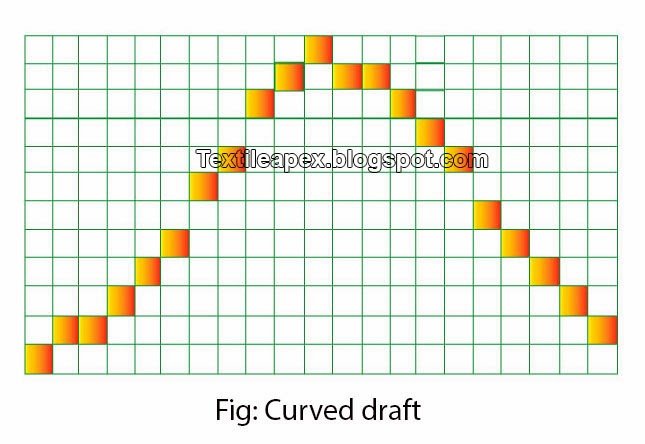Systems or Classification of Drafting Plan
Last updated on August 22nd, 2023 at 11:23 pm
Classification of Drafting Plan
Straight Draft
Straight draft is the most common and can be used with any number of shafts. Each successive thread is drawn on successive shafts, the first thread on the first shaft, the second thread on the second shaft, and so on. The last thread of the warp repeat is drawn on the last shaft. Thus the number of shafts equals the warp repeat and the repeat of draft equals the warp repeat.

Uses: Used in twill design.
Pointed Draft
Pointed drafts are used where the straight draft cannot be applied. This draft can be considered as a combination of straight drafts. A straight draft is returned in the opposite direction at a predetermined point. The first and last heald shafts equals to half of the number of threads in warp repeat.

Uses: Used to produce fabric with symmetrical design e.g. jig-jag twill, Diamond.
Skip Draft
The warp ends are threaded in an irregular way. Warp ends with the same action are threaded through the same shaft. The number of heald used is multiple of two or more than the number of threads in one repeat. In case of the plain weave, may be drawn on two healds, if the cloth is coarse; or on four healds, if the cloth is of medium fineness; or on six healds, if the cloth is very fine.

Uses: This system is particularly useful in weaving very densely fabric.
Broken Draft
It can be considered as modified pointed draft. Again it is a combination of straight drafts with different directions of constructing. But the direction is reversed not on the last or the first shaft. When the direction is reversed the first thread of the next group is started higher or lowers than the last thread of the preceding group. This small modification changes considerably the design by breaking the axis of symmetry. The order of interlacing of the last thread of the first group is opposite to that of the first thread of the preceding group.

Uses: This draft is applied for producing herringbone twills, diaper design and etc.
Divided Draft
The shafts are divided into two or more groups. A suitable type of draft is chosen for each group. The divided draft is employed for double-warp fabric. There are two systems of warp threads: The face and back ones.

Uses: The draft is employed for derived weaves, double warp weaves, two ply weaves, pile weaves etc.
Grouped Draft
Two sets of stripes are used in two set heald shafts. Warp of each group passed through a particular group of healds adjacently and the other set of warp is inserted through another group of heald adjacently.

Uses: This draft is used for producing check and stripe fabric.
Curved Draft
The minimal number of shafts equals the number of threads in warp repeat with different order of interlacing. The drawing-in is done applying the rule: All warp threads which works alike are drawn on the same shaft. They are irregular and cannot be classified.

Uses: Used to produce decorated weave with large repeat unit.
Combined Draft
It is a very complicated type of draft. It can be chosen if there are some technological or economical reasons. Great experience is required for such drafting plan.

Uses: In producing some special type of fabrics different type of drafts are required to be mixed.
You may also like: Honeycomb Weave Fabric Structure: An Overview




Everybody should know about it…
Howdy, would you mind letting me know which web host you’re utilizing? I’ve loaded your blog in 3 completely different web browsers, and I must say this blog loads a lot quicker then most. Can you suggest a good internet hosting provider at a reasonable price?